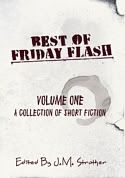Thanks for stopping by. I hope you enjoy what you find here. Whilst you may not agree with everything I post, if you respect my right to my opinion I'll respect your right to disagree with it and we should get along just fine. :)
Disclaimer: the views expressed by the characters in these works may not necessarily represent the views of the author. Got that? Good.
Right then, on with the blog...
Disclaimer: the views expressed by the characters in these works may not necessarily represent the views of the author. Got that? Good.
Right then, on with the blog...
Thursday, 26 November 2009
Friday, 20 November 2009
#FridayFlash: Mr Fluffles and the Art of Feline Psychiatry.
Well, here it is, my first attempt at #fridayflash fiction. By way of an introduction, this is the sort of thing that happens when I’m trying so hard to write something else and not getting very far! I swear this story wrote itself. I was in two minds whether or not to post it as it still needs some work (did I mention this is my first attempt?), but after two days I’m in danger of tinkering for tinkering’s sake, so here we go…
Mr Fluffles and the Art of Feline Psychiatry.
‘There’s this cat, see? It’s following me. It’s everywhere I go. It was bad enough when it moved in, but it follows me when I go out too! There it was, sitting outside the supermarket last Saturday morning when I went to get some breakfast. And it was still there when I came out. And at the dentist’s yesterday. It followed me home, again. On the bus. The driver thought it was funny, a cat using the bus by itself – he said so. But it wasn’t. Not to me at any rate. That cat’s been following me everywhere for the past month and it’s creepy, like it knows what I’m thinking or something.
I like cats, used to have one when I was a kid, but this one’s not normal. It’s the eyes. Don’t get me wrong, it’s a lovely looking thing, sort of a marmalade cat with a white bib, but that’s not the point. It’s evil. I’ve even tried boarding up my windows, but it still gets in, somehow.
The damn thing even followed me to my Mother’s house this morning. I went to see her before I came here, and it came in with me and, and, she fed it! The silly woman fed it, right there in her kitchen. She can’t see how dangerous it is, not like I can. I know what it’s up to, I know! And I’m scared that after it’s finished with me it’ll go after her.’
The young man shifted nervously in his chair, wringing his hands while the nervous tic beneath his left eye beat out its silent Morse code. He wondered how he was going to make the man seated across the desk from him understand without giving too much away.
‘It’s OK, Mark,’ Dr Brown said slowly in his best “reassuring the patient” voice. ‘We’ve been here before, now haven’t we?’ he continued, running a hand through his thinning grey hair, ‘and do you remember what we agreed last time? Stick with the medication and the relaxation exercises, keep your CPN appointments, and everything will be just fine, I’m sure.’ He smiled.
Patronising git, thought Mark.
Dr Brown scribbled something on his prescription pad, tore the sheet free and held it out to Mark.
‘Thinking about it,’ he said as Mark reached out a thin, bony hand for the prescription, ‘I’m going to change your medication. I think this tablet will be better for you. Take one in a morning and one before bed, and any problems with side-effects, just give my secretary a ring.’
Mark shoved the prescription into a pocket of his filthy, torn, army surplus combat jacket.
Dr Brown’s voice became suddenly serious, ‘Do not,’ he paused, ‘Exceed the stated dose. This drug’s fine at the usual dose, but can be quite dangerous if you take too much. OK?’
Mark nodded.
‘And make an appointment,’ Dr Brown said, switching back to his reassuring voice, ‘with my secretary for next week. Try not to worry Mark, we’ll get you sorted out, it just takes a bit of time to get the treatment right.’
Standing, Dr Brown extended his hand as a sign the consultation was over and watched as the unkempt young man left his consulting room. Would he take the hint about the medication, Dr Brown wondered. It might be easier all round if he did.
The clickety-click of slightly over-long claws catching in the weave of the deep shag pile carpet made Dr Brown stiffen and, looking over his right shoulder, he watched as a large white tomcat padded slowly into the room from the half open door of the private bathroom adjoining the office.
Dr Edmund Brown, consultant psychiatrist, slumped into his leather executive desk chair as the cat jumped silently onto the end of his desk and began to wash its face. It was a very nice chair, deep chocolate brown Italian leather, and fitted in perfectly with the other high-end fittings of his large, plush consulting room. He thought he would rather like to keep the chair, the office, his current lifestyle, so when the cat nudged his hand and meowed, Dr Brown sighed quietly to himself, opened a new blank word processing document and pushed his laptop towards the cat.
Slowly, carefully, the cat began to type with its right forepaw, one key at a time. Dr Brown almost smiled at the look of concentration on its face. Yes, he thought, he would like to keep the office, all except for the large potted palm by the door to the outer office. He’d keep that too if the cat would stop pissing in the pot, he thought with a momentary flash of irritation, which he quickly suppressed. The cat paused. Dr Brown made a swift mental apology and the cat resumed its typing. When the cat had finished, it stared up at him, baleful yellow eyes making contact with his pale blue ones.
Retrieving the laptop, Dr Brown dialled the number the cat had typed, the telephone only ringing twice before an efficient voice answered.
‘Liquidation Team, how may…’
‘Mr Fluffles has another job for you,’ Dr Brown interrupted flatly, reading out the cat’s instructions before giving Mark’s address and personal details. He pictured the cat that ran the Liquidation team, a black tomcat with a penchant for typing “Go! Go! Go!” DCI Gene Hunt, with fur.
‘Thank you,’ said the disembodied voice when he’d finished, and the line went dead.
The medication, Dr Brown thought, remember the medication, Mark – make it quick and painless, before it’s too late.
Looking down at his hands, Dr Brown realised they were shaking, and he was perspiring profusely. He rose from the chair and walked towards his bookcase, intent on the eighteen-year-old bottle of single malt currently residing behind his copy of Freud’s Dictionary of Psychoanalysis.
On the desk, Mr Fluffles smiled. This one, he thought, watching Dr Brown fumbling with the bottle top, had potential.
* * *
If you enjoyed the story, check out more #fridayflash fiction here, and don't forget to Twitter Search the #fridayflash hashtag.
#FridayFlash: Mr Fluffles and the Art of Feline Psychiatry.
Thursday, 19 November 2009
Scripto
The first time I came across the name Scripto was in an email I received some time ago from my good friend George over at My Supply Room. Initially I wondered what it was all about as the name sounded to me a bit like a 1950s superhero! Not so.
Scripto, it turned out, is the name of an American company (still in existence today as ScriptoUSA), which produced a range of mechanical pencils and graphite leads from the early 1920s to the mid 2000s. In 1955, Scripto also began producing a range of refillable lighters marketed under the name of ‘Vu-Lighter,’ and later they manufactured a range of ballpoint pens. More information on the history and products of the Scripto company can be found at George’s blog, or at Roger Russell’s website.
 George very kindly offered to send me a package of Scripto pencils, though owing to postal delays, which were down to either USPS or Royal Mail not George (just wanted to make that clear), George decided he would mail a second package just in case the first one had been lost. Imagine my surprise when, almost within days of each other, the two Scripto packages arrived.
George very kindly offered to send me a package of Scripto pencils, though owing to postal delays, which were down to either USPS or Royal Mail not George (just wanted to make that clear), George decided he would mail a second package just in case the first one had been lost. Imagine my surprise when, almost within days of each other, the two Scripto packages arrived. Thanks to George’s immense generosity, I reckon I probably have one of the largest, or most complete Scripto collections in the UK! I remember we joked about it at the time, wondering if my collection warranted a knighthood or something – so if the right people are reading this, an OBE will do just fine, thanks.
Thanks to George’s immense generosity, I reckon I probably have one of the largest, or most complete Scripto collections in the UK! I remember we joked about it at the time, wondering if my collection warranted a knighthood or something – so if the right people are reading this, an OBE will do just fine, thanks. 
All the pencils now in my collection are great, but there are a few that, for me at least, are true gems – the first of these is the WordMaster:
 Produced in the mid 1940s, the WordMaster really is a thing of beauty. Measuring just over 5 inches in length, and weighing 20g, it features a gold plated clip, bands and point – that’s real gold by the way! The cap is a push fit, which can be removed to give access to an eraser, beneath which there is storage space for an additional six leads. The WordMaster operates using a twist mechanism for extending the lead and, whilst a bit stiff, the one in my collection still works, not bad for a pencil made around sixty years ago. Roger Russell’s site features a WordMaster advertisement from the May 31st, 1947 Saturday Evening Post magazine, which shows these pencils were originally sold for $1.00!
Produced in the mid 1940s, the WordMaster really is a thing of beauty. Measuring just over 5 inches in length, and weighing 20g, it features a gold plated clip, bands and point – that’s real gold by the way! The cap is a push fit, which can be removed to give access to an eraser, beneath which there is storage space for an additional six leads. The WordMaster operates using a twist mechanism for extending the lead and, whilst a bit stiff, the one in my collection still works, not bad for a pencil made around sixty years ago. Roger Russell’s site features a WordMaster advertisement from the May 31st, 1947 Saturday Evening Post magazine, which shows these pencils were originally sold for $1.00!The second of my gems is this, the Scripto Classic:
 I have two Scripto Classics, sometimes referred to as the twist or spiral type, one green and one blue, and both in fully working order. They really are a joy to use – simply grasp the pencil and twist the chrome band above the clip to advance the lead.
I have two Scripto Classics, sometimes referred to as the twist or spiral type, one green and one blue, and both in fully working order. They really are a joy to use – simply grasp the pencil and twist the chrome band above the clip to advance the lead.The rest of my collection is made up of Scripto pencils manufactured USA, Mexico, Japan and Korea, among others, and I am having great fun learning more about this famous manufacturer as I slowly catalogue the collection.
Before I sign off, here’s a pic of the ‘Vu-Lighter’ butane lighter George also kindly sent me:
 George recommended I should be careful when filling, as sometimes these lighters developed a leak around the filling aperture and you could end up with a handful of lighter fluid if you weren’t careful! No such problem with this one though, as George had it serviced before he sent it to me.
George recommended I should be careful when filling, as sometimes these lighters developed a leak around the filling aperture and you could end up with a handful of lighter fluid if you weren’t careful! No such problem with this one though, as George had it serviced before he sent it to me.PS: I wouldn’t want my readers thinking this was all a one way trade, I did sent George some Pentel pens he was having trouble sourcing for his own collection, which he blogged about here, and here.

Scripto
Sunday, 8 November 2009
Remembrance Sunday - We Will Remember Them
In the United Kingdom, Remembrance Sunday is the second Sunday of November, the Sunday nearest to 11th of November (Remembrance Day), which is the anniversary of the end of the hostilities of the First World War at 11 a.m. in 1918.

On this day, people across the UK pause to reflect on the sacrifices made by our Service men and women, both in current conflicts and those of the past. In 2009 Remembrance Sunday is Sunday 8th November. The Two Minute Silence is a customary part of Remembrance Sunday, and this year, for the first time, there are plans for The Two Minute Silence on Twitter (thanks to @PoppySupport) starting at 11.00am GMT. Please support it if you can.
 From The Royal British Legion website:
From The Royal British Legion website:The Royal British Legion has always supported the traditional Remembrance Sunday services and the customary Two Minute Silence on that day. As the national custodian of Remembrance, the Legion also believes that when 11th November (Armistice Day) falls on days other than Sundays - on working days - Remembrance should be brought into the everyday life of the nation on those days as well.
The Royal British Legion was formed in 1921 to support the veterans of the Great War. Since then, Britain has been involved in many other wars and fields of Service, creating a continuous supply of Service men and women, and their families, who need assistance.
The Legion helps people of all ages and backgrounds. To be eligible for our help, they must have served in the Forces for at least 7 days, or be the dependant of someone who has served. It really is that simple.
Each year support for The Royal British Legion's charity work is through the Poppy Appeal.
The first official Poppy Day was held in Britain on 11th November 1921, inspired by John McCrae's poem In Flanders' Fields. Since then the Poppy Appeal has been an annual event. The Poppy Appeal's current theme, "Serving those who Serve," emphasises the way in which the appeal's focus is shifting with the increasing need to help the service personnel who are serving today, as well as ex-service personnel and their dependants.
 The iconic Poppy worn by so many on Remembrance Day was first produced in 1922 after Major George Howson formed the Disabled Society to help disabled ex-service men and women from the First World War. The original poppy was designed to be easily assembled by workers with a disability.
The iconic Poppy worn by so many on Remembrance Day was first produced in 1922 after Major George Howson formed the Disabled Society to help disabled ex-service men and women from the First World War. The original poppy was designed to be easily assembled by workers with a disability.For more information about the Poppy Appeal, please visit www.poppy.org.uk and for information about the history and current work of The Royal British Legion, please visit www.britishlegion.org.uk
On a personal note, MIL was a member of The Royal British Legion and a lifelong supporter of the Poppy Appeal, the retiring collection at her funeral raised over £280 for the Poppy Appeal, so Remembrance Sunday will be particularly poignant for us this year.
Pictures courtesy of The Royal British Legion
Remembrance Sunday - We Will Remember Them
Subscribe to:
Comments (Atom)

























